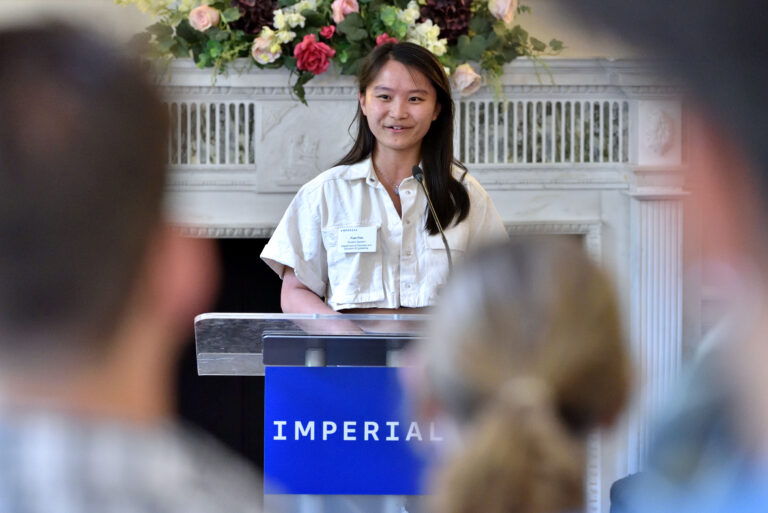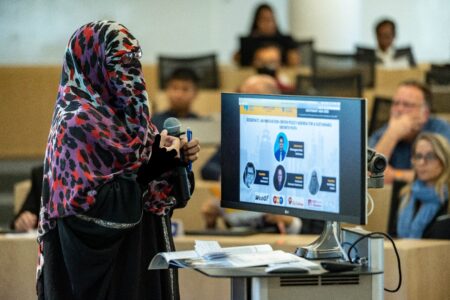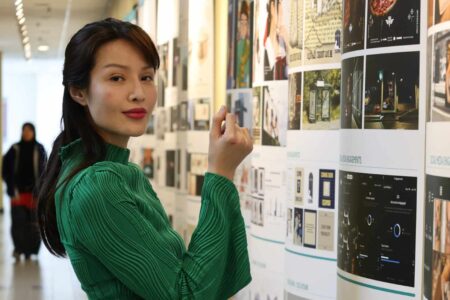
When Fion Foo Feng Shen was nine years old, she came across a brochure advertising a new extracurricular offered by her school.
The activity in question? Robotics.
As an adventurous soul who liked trying new things — Foo already had art, ballet, and piano in her repertoire — she decided to give robotics a try, too.
“It was just following instructions to build and run the robot,” says Foo. “I was quite good at that, though everything was pretty straightforward.”
Fast-forward past the trial classes, Foo ended up participating in a national robotics competition in Malaysia, albeit at a regional level. There, she headed a team that included herself and two boys a year her junior, snagging first place and moving onto the national level and ultimately earning a consolation prize.
At that point, she never imagined that taking up robotics as an extracurricular activity would eventually lead to her obtaining a First Class Master of Engineering in Electrical & Electronic Engineering from Imperial College London – only one of the most in-demand degrees at one of the most highly ranked universities in the world.

Like many international students, Foo’s decision to study abroad easily opened the doors to new experiences and opportunities for her to dive into. Source: Fion Foo
‘The best decision in my life’
By the time Foo had to choose what to pursue in university, she had three choices: mechanical, electrical, or mechatronics engineering.
While part of these choices were due to previous interest in robotics, Foo credits her family for offering advice and personal insights into what each field would entail.
Foo’s father, a civil engineer, suggested taking the electrical route, citing its good career progression.
It was something that he and Foo had seen first-hand since Foo’s cousin and uncle were in the field. “He’s one of the most respectable uncles out there, and so I was like, ‘yeah, I’ll go with electrical engineering,’” she says.
From there, she found, applied, and was accepted into Imperial College London.
“The decision that I made to study in the UK was one of the best in my life,” says Foo, and it’s clear why.
In the first year of her studies, Foo discovered that she could participate in a research exchange – specifically, Imperial’s International Research Opportunities Programme (IROP) – or spend a year abroad during her programme. “Once I got to know of that opportunity, I knew I wanted to apply for it,” she says.
In the summer of her third year in July 2023, while her peers were preparing for their paid internships, Foo packed her bags and was off to Cornell University in New York for a 10-week research programme.
“Most people would prefer earning money during the six-month internship, but I really valued the experience I had in the US,” says Foo.

It’s one thing to be able to spend time at an Ivy League university, but it’s another to pack your bags and solo travel the US for a few weeks. Source: Fion Foo
And it wasn’t just because she was in an Ivy League school and an institution that ranked 16 on the QS World University Rankings 2025. That experience came with its share of wonder, but Foo’s biggest takeaway came from her three-week solo travels around the US after completing her programme.
In a LinkedIn post, Foo talks about taking overnight flights and bus rides, and staying in hostels with up to 16 bunk beds or house-sharing with strangers. She travelled to New York City, Los Angeles, Silicon Valley, San Francisco, and Colorado.
“It opened my eyes to a lot of different stuff. I saw new perspectives, met new people, and got some direction on what I wanted to do after my trip,” she shares. “I feel like the people there are braver and more adventurous when it comes to doing what they want to do, like starting new projects, for example.”

It’s not just engineering too — Foo is an avid basketball player, even representing Imperial College London’s women’s basketball team in various tournaments. Source: Fion Foo
Keeping the ball rolling for women in engineering
Taking a leaf out of the Americans’ book, Foo returned to Malaysia and started her own project.
“I’ve always wanted to share my experience because I know that not everyone has a chance to go overseas, and they might like to learn from me,” says Foo.
When the opportunity to receive a grant from the Young Southeast Asian Leaders Initiative (YSEALI) came, Foo rallied her friends from electrical and electronic engineering, computer science, and computer engineering together to form ELECTRO, an educational initiative to inspire young students to pursue a career in STEM (Science, Technology, Engineering, and Mathematics), specifically in the electronics and semiconductor industry.
While ELECTRO did not receive the grant in the end, the group was determined to continue the work.
For the collective group, this initiative was something that they wished they had when it came time to explore options after the secondary school examinations were complete. On the side, Foo wanted to have women speakers to show students that women engineers weren’t a myth.
“When I started this initiative, I didn’t emphasise just speaking to girls because I don’t think going to a school and telling them, ‘You should join STEM,’ is the correct way to do things,” says Foo. “The idea was to have more female speakers instead and sort of working indirectly by getting them to share their experience, which I hope is a way to help break the stereotypes of having just male engineers or male electrical engineers.”

The world needs more women in engineering, and Foo and the team at ELECTRO are more than ready to help support that growth. Source: Fion Foo
It’s an experience that Foo has lived herself, after all.
In the first year of her programme at Imperial, 18% of the class were female. It was the same as the years went by, and despite people dropping out, “you could still list out all the girls in the class,” she says.
By her final year, once students had been sorted into their specific tracks of electrical and electronic engineering or electronic and information engineering, Foo’s class of 58 students only had 12 females, including herself.
Not only that, Foo only recalls having a single female lecturer throughout her courses, though she does add that there may have been other female lecturers for other optional modules.
Regardless, the number of women in engineering – or lack thereof – is glaring.
- In 2023, men outnumbered women in the global engineering workforce 86.3% to 13.7%.
- The US Bureau of Labor Statistics reported that in 2022, women represented 16.1% of all employed persons in architecture and engineering occupations in the country. Women in mechanical engineering and electrical and electronics engineering comprise less than 10% of the workforce.
- Among 25- to 34-year-olds with a STEM bachelor’s degree in the US in 2021, women are underrepresented in engineering and computer careers compared to men of the same racial/ethnic origin. Black and Asian women, in particular, are the most underrepresented in engineering careers, reports the Society of Women Engineers.
Still, it’s one of the many things that ELECTRO and Foo hope to tackle someday.
For now, they’re beginning simply by sharing the various routes a Malaysian high school graduate can take and introducing and exposing students to different and niche programmes that they might not have heard otherwise.
Ultimately, the focus remains on electrical and electronic engineering, computer science, and computer engineering.
“Whether we go in-person to schools or make content online, we just want to expose the topic to as many students as we can,” says Foo.










